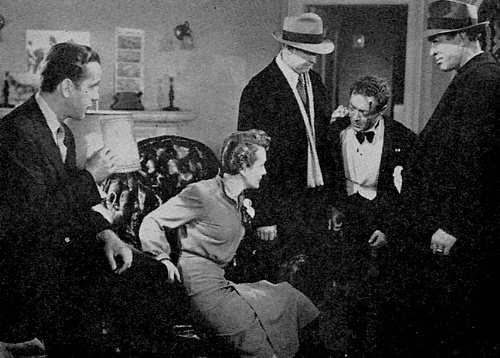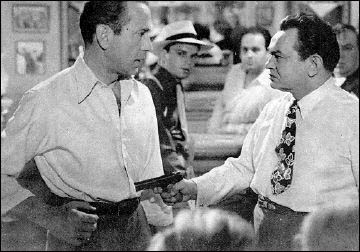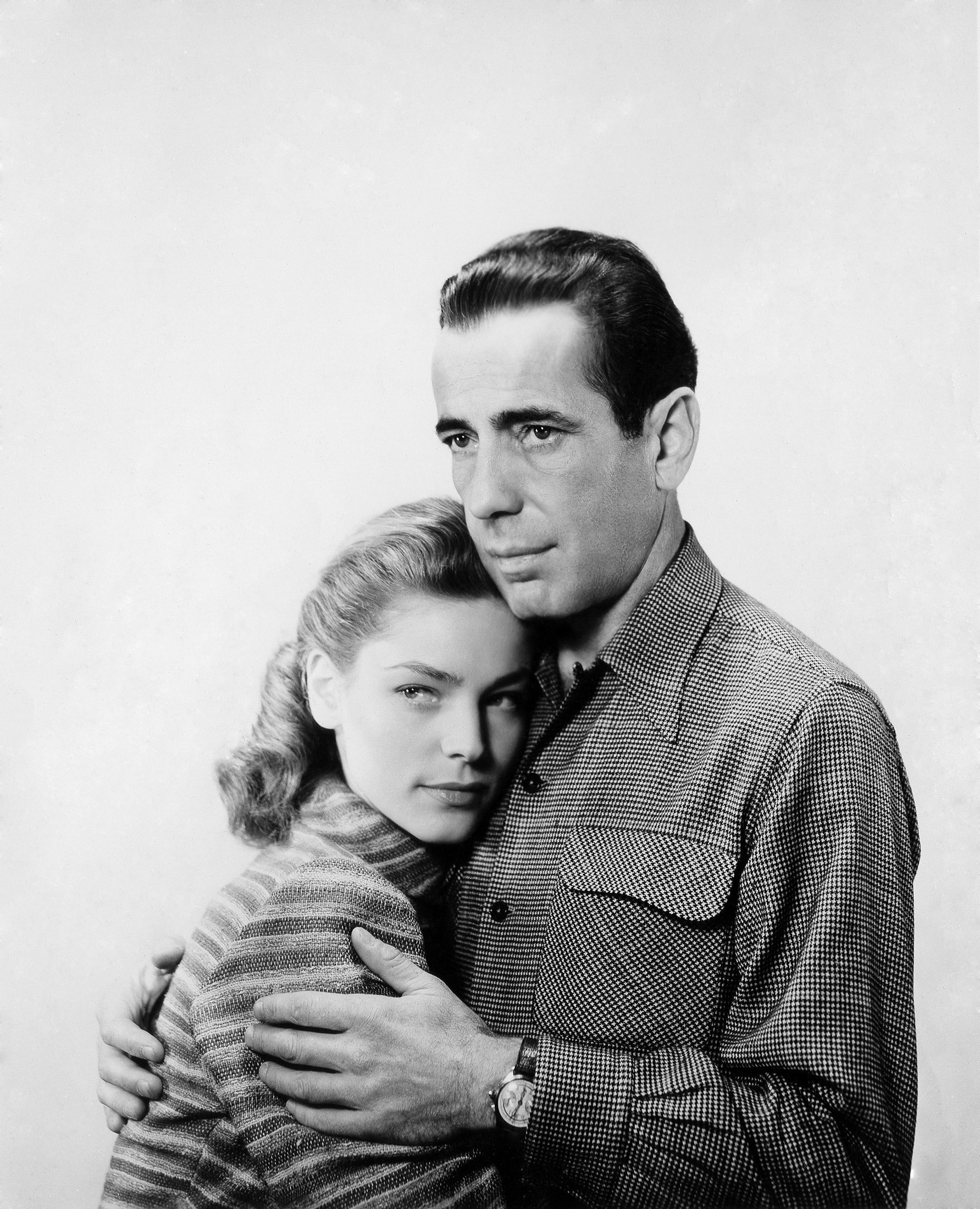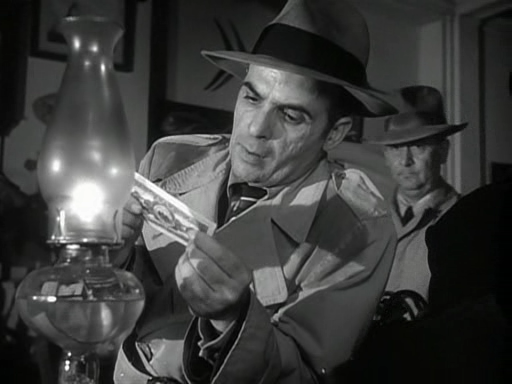Movie Review – Key Largo (1948)

Principal Cast : Humphrey Bogart, Lauren Bacall, Edward G Robinson, Lionel Barrymore, Claire Trevor, Thomas Gomez, Harry Lewis, John Rodney, Marc Lawrence, Dan Seymour.
Synopsis: A man visits his old friend’s hotel and finds a gangster running things. As a hurricane approaches, the two end up confronting each other.
********
There’s a moment at the beginning of the second act of Key Largo (the film was adapted from a play by Maxwell Anderson, and certain theatrical conventions– the sense of an act-break, the semi-proscenium blocking of some of the scenes– remain) where young widow Nora Temple (Lauren Bacall), having fallen asleep during the film’s centerpiece hurricane near Frank McCloud (Humphrey Bogart), seated watchfully next to her on the floor of the lobby of the Largo Hotel, wakes, raises her head, and looks up into his eyes, and he looks back at her. That’s all. In a moment, the gangster dramatics of the film will resume, as Johnny Rocco (Edward G. Robinson) and his men plot how they will get themselves and their counterfeiting money to Cuba now that the hurricane has passed, but for now we can enjoy simply being privy to a key to Bogart’s success: the fact that Hollywood’s most legendary tough guy knew the absolute importance of tenderness.
Key Largo was Bogart and Bacall’s fourth, and final, film together. (A year earlier, in 1947, their third co-billing, Dark Passage, played to less-than-enthusiastic reviews: the film, about a wrongly accused, escaped con [Bogart] who has plastic surgery in order to elude recapture, is fascinating and nightmarish; we follow Bogart’s character up and down the impossible hills of San Francisco via first-person point-of-view until it’s revealed midway through the film that the surgery has “given” him Bogart’s face. Not having Bogart actually present on-screen for half the film’s running time, as well as the script’s weak ending [Bogart finds the real killer, but she commits suicide before he can bring her to the police], stifled Dark Passage at the box office.) In real life, despite a twenty-year age difference, they’d been happily married for several years, and to critics it showed: they were too comfortable with one another onscreen. The sexual spark they’d displayed in To Have and Have Not and The Big Sleep was gone.
To which I respond: Stifle it, naysayers. Key Largo is an entirely different type of animal.

The opening of the film tells us that the Florida Keys are a string of islands at the southernmost tip of the United States, strung together by a concrete causeway some two hundred miles long. It is just after World War II. Frank McCloud, who served honourably as an army major in the Italian campaign, now wanders the United States in disillusionment. As befits his name, he’s a drifter, but he’s not a bum. He’s neatly dressed; he has a worn, weary dignity. Unable to resettle himself on land in the post-war world (he was, before the war, a circulation manager for a newspaper), he’s come to the Keys to try life at sea– as a hand on a fishing boat, anything. (His first love, he tells Nora– and, unwittingly, several characters less sympathetic– was a boat.) En route to Matacumbe Key, he stops at the Largo Hotel to pay his respects to the family of one of the young men, George Temple, who served bravely, and died, under his command.
There, he finds, things don’t seem right. The hotel lobby contains no one but thuggish– if too carefully polite– men. “Hotel’s closed,” intones a young, dead-eyed dandy in wide suspenders and a broad fedora. At the hotel’s modest bar, a woman, Gaye Dawn (Claire Trevor, who most deservedly won a Best Supporting Actress Oscar for her work here), a once-upon-a-time beauty who’s obviously seen better days, balances fretfully on a barstool while she listens to horse races on the radio. Frank politely asks the beefy man behind the counter for a beer. “Bar’s closed,” the man replies. “Give him a beer,” Gaye says, her voice rising in frustrated fury when the man ignores her: “GIVE HIM A BEER.”
We might think that this is where the shooting, or at least the scuffling, should start; it’s as obvious at this point to Frank as it is to us that he’s stumbled into a nest of cinematic vipers. But so far the vipers are doing more slithering than biting, we’ve yet to meet the big snake in charge, and Frank isn’t interested in being a hero (or, as we’ll see, in being a hero until he’s had a chance to observe and assess the situation, a pragmatic intelligence that he insists is nothing but self-interest).

More importantly, director John Huston (who also co-wrote the script) has to introduce us to Nora Temple (a purely beautiful Bacall, as radiantly sleek as a mountain lion) and her crippled father-in-law, Mr. Temple (the legendary Lionel Barrymore, confined here, as in real life, to a wheelchair). The thugs seem genuinely relieved when Frank tells them he’s there only to see Mr. Temple, not out of fear of Bogart, exactly, but out of practicality. We get the sense that they’re only passing through, too, and that unnecessary murder would only make things messy.
With Frank’s introduction to Temple and Nora, Huston hands us a beautifully moving series of scenes. We have to keep in mind how near the film was to the end of the Second World War, in story and in reality; Bacall’s blue-gray eyes are luminous in black and white, and they shine quietly with sorrow and apprehension as Nora asks Frank: “Were you with George when he died?”
“Yes,” Frank replies gently.
A question a million mothers and wives would have yearned to ask: “Was he in very much pain?”
“He never knew what hit him.”
Here is where we first encounter the main theme Max Steiner composed for the film’s score, a simple twenty-note melody that plays heartbreakingly on Taps. Nora looks relieved, though her face loses none of its numb grief. “I was afraid he might have suffered.”
She and Frank go to join Temple, who is waiting for them in a study on the hotel’s main floor. Nora and Temple have only George’s picture, a medal, and the State Department letter that informed them of his death. Frank kindly fills in details for them, telling them what a good and respected soldier George was. (And, as we’ll find out later, he builds George up at his own expense.)
As Frank talks, director Huston gives us our first direct look at the thematic current underlying Key Largo: heroism and cowardice come in many different forms. Foolishness does, too: it relates to both of them, sometimes detracting, sometimes augmenting, sometimes disguising itself as one or the other. Frank, here, is being as tactful and sincere as he could– and should– be. George, he tells Temple and Nora, was a born hero, always looking for ways to do more for his regiment. “He couldn’t imagine his own death,” Frank says. “Only dishonour.” We see the struggle in his face, even if Temple and Nora don’t: Frank respects the memory of the dead boy, and he certainly respects the feelings of George’s father and widow. But, after what he’s seen in war, after the disillusionment of peacetime, does Frank respect heroism itself?
We’re about to find out.

Temple and Nora insist that Frank stay the night, but there’s a storm warning in effect: a hurricane is coming. My favorite shot of the film comes when Frank and Nora go out to secure the hotel’s boat. It’s a simple thing, Bogart and Bacall walking side by side as the rising wind flutters their hair, but, as Steiner turns his twenty-note theme into a fully orchestrated march, we know: in Key Largo, the good guys wear white. Or white shirts, anyway: Frank and Nora are wearing nearly identical button-down shirts, uniform and softly crisp, for the moment, even in the tropical Floridian heat. These are our heroes, the scene says, even if Frank might deny it.
Our villain, the chief snake in Hotel Largo’s nest of vipers, is upstairs in a bathtub, trying to keep cool. He’s Johnny Rocco, gangster king, and Johnny Rocco is Edward G. Robinson. It’s a daringly unflattering first shot, Robinson in the tub, his barrel chest clumped with black hair, his face sheened with sweat as he sprawls with a cigar in one hand, a drink standing by on the rim of the tub. But Rocco’s ego and Robinson’s talent are up to the challenge. Even naked in a bath, he’s very much in charge.
Both Robinson and Bogart were known for their onscreen villainy. That was the surface. Below it, we find men of great thoughtfulness and, offscreen at least, of great humanity and compassion. Both of them are short, homely. Bogart’s head is too big for his frame; he’s not leading-man handsome. Nevertheless, though he’s known for the snarling, paranoid animalism of characters like Duke Mantee in The Petrified Forest and Fred Dobbs, the gold prospector driven mad by greed in The Treasure of the Sierra Madre, the set of his mouth– precise, sculpted– belies his sensitivity, as do his eyes, dark and basset-mournful. Robinson’s face, like his body, is broad, blockish; his mouth is wide, a gash or a perpetual sneer. He looks like a toad. The joke ran that he and Bogart alternated shooting each other in the films they made together. In Key Largo, both of them end up shot, but only one of them– only one of their characters, of course (not only are we well into the Production Code era, so we never see blood on a torso, but Robinson and Bogart had a genuinely respectful, genial working relationship)– lives to tell.

Much to John Huston’s credit, we’re not sure until the film’s end which of the two– Rocco or Frank– the survivor will be. (Even then, the winner doesn’t walk away unwounded; the film ends in fog over the ocean following a storm, and we’re left with a niggling sense that a happy ending, while likely– again, we’re well into Code times, and evil isn’t meant to triumph– isn’t a given.) Huston, who produced a number of controversial documentaries for the United States government during the war, presents us with a sober, realistic examination of bravery and cowardice. Even more unflinchingly, he shows us how bravery can be mistaken for cowardice:
Sawyer, a local sheriff’s deputy, checking the hotel’s grounds for two young Seminole brothers who’ve broken out of the local jail, finds himself captive with Frank, Nora, and Temple when Rocco and his men reveal themselves as the gangsters they are. Rocco taunts Frank; he torments Temple until the older man rises from his wheelchair to strike him, and falls (keep in mind that Barrymore at this point was in fact wheelchair-bound: the kindly Robinson found the scene viscerally difficult to shoot). With a moray-eel leer, Robinson asks Frank what he wants out of life, after Frank and Nora help Temple back into his chair.
“I had hopes once, but I gave ‘em up.” Frank’s body language is neutral, edging on defeat. His shoulders sag slightly. “A world in which there’s no place for Johnny Rocco.”
Rocco grins. “Got a chance to make your hopes come true. But you gotta die for ‘em.”
And he tosses Frank a gun. He takes out his own. Frank can kill him, but Rocco will have a shot, too. As will his men. And Nora and Temple are in the room, as are Gaye and Sawyer. Frank sets the gun down.
“One Rocco more or less isn’t worth dying for,” he says.
He’s protecting Nora and the others, but she has yet to realise it. Robinson turns to her in mock sympathy. “What’s the matter, sister? You look like you lost someone near and dear.” He looks back at Frank in genial contempt, very much the king here, casual and in charge. “A live war hero. Now I know how you did it.”
Sometimes you have to look a coward to be a hero. Frank, an experienced combat veteran, knows this: the patience, the planning, the discipline. Temple and Sawyer, unfortunately, are heroes in a more popular, storied sense. “Gimme that gun,” Temple says, once Frank, the apparent coward, sets it aside. Rocco chuckles. “No, I’m afraid you’d use it. One old man more or less isn’t worth dying for.”
Then Sawyer grabs the gun, points it at Rocco, pulls the trigger–
Click.
It’s empty.
Rocco shoots him. And Sawyer, the brave one, the “pure” hero, dies. Ironically, we get the sense that George was such a hero; earlier, when Frank told Temple and Nora how fine a soldier George was, he said it was a wonder George lasted as long as he did, given his willingness to volunteer himself.
Now, a shocked Temple tries to persuade Frank that Frank wasn’t a coward in refusing to play Rocco’s game. “You weren’t afraid, son. We all know that.”
“Oh, yes,” Frank insists in response, “I was afraid.” The next lines, lifted nearly verbatim from Casablanca, echo the mantra of Bogart’s Rick Blaine, cinema’s prototypical anti-hero: “I only care about me and mine. I fight nobody’s battles but my own.”
What he can’t say is that Nora and Temple are his now, and that his battle is to save them. Which he can’t do if he sides himself openly and recklessly with glory and gets himself killed.

In Frank McCloud we have one of the most realistic heroes ever to appear onscreen. He’s intelligent, but probably not extraordinarily so; his strength lies in his powers of observation and in his ability to take his time, to think a situation through. He’s patient; he keeps his head. For a time, he wryly plays the role of court jester to Robinson’s crime-emperor Rocco, keeping Rocco’s ego buttered while Rocco himself is kept slightly off-balance: Frank, in telling an angry Temple, “You don’t know who you’re talking to,” with regard to the criminal celebrity in their midst, prevents Temple from becoming a target.
In Frank, we see a man who’s a hero not because someone murdered his parents or his family or because he’s otherwise got a massive chip sitting on his shoulder, but because he’s a decent guy and he simply can’t help it. Revenge fantasies and radioactive spiders need not apply. Frank’s task is to take a stand against evil, and he must do so as an ordinary man. Here we find John McClane as he was at the very beginning of the very first Die Hard movie, before he could ricochet cop cars into helicopters or play tag with Harrier jets. When Frank contemplates a beating at the hands of one of Rocco’s men, when Rocco jabs the muzzle of an automatic into his gut, we feel Frank’s fear. He’s not indestructible.
Which makes his heroism, when he finally reveals it, all the more effective. Alcoholic Gaye, deeply rattled by the shooting of Sawyer and by the howling of the hurricane outside the hotel, begs Rocco for a drink. She can have one, Rocco tells her, if Gaye, a one-time nightclub performer, will sing for them. She does, reluctantly, desperately, and, ultimately, very badly (Huston shot the scene without giving Trevor time to prep, so her increasingly off-key performance is that much more sad and convincing.). Rocco refuses to give her the promised drink, and Gaye bursts into tears. Without a word, Frank walks past Rocco’s goons to the bar, pours Gaye a glass of whiskey, and takes it to her. “Thanks, fella,” she says gratefully.
Rocco steps up to Frank and slaps him hard– one, two, three– across the face.
“You’re welcome,” Frank replies to Gaye. And Rocco’s power shifts, crumbles at the edges, while Frank goes and seats himself, calmly, near Nora, who now recognises Frank’s courage for what it is.
“He might have killed you,” she says, “but that made no difference. You had to help her. Your head said one way, but your whole life said another. A cause isn’t lost as long as someone is willing to go on fighting.”
“But I’m not that someone,” Frank insists softly, as one of the goons paces by.
“But you are,” Nora says. “You may not want to, but you can’t help yourself. Your whole life’s against you.” As proof, she offers the fact that in his final letter home, George provided a different version of a story Frank told her and Temple: while Frank told them that George once manned a forward observation post all on his own for three days when the others with him were killed, the positions were, in fact, switched. Frank was the one directing artillery fire by himself, while he talked to George on the field phone to keep himself awake. A gentle lie for George’s family, but now Frank has been caught out.

And now Nora recognises the face as well as the price of bravery. To do battle with evil, to do battle with it really, to defeat it, you have to be as insidious as that evil. You have to be patient, no matter the pain, the humiliation, or the horror. Frightened by Rocco’s threats and the terrible weather, the captain of the boat that was to take the gangsters to Cuba has taken his yacht and gone. Rocco pegs Frank as replacement ferryman (after all, as his men overheard Frank say earlier, Frank’s first love was a boat, right?). He agrees, while Gaye and Nora, in a moment of privacy, do their best to dissuade him, to run when he has the chance. But, as Nora has reminded him, Frank’s whole life is against him. He sets off with Rocco and his men for Cuba. And when Frank has put a chunk of safe distance between himself and those he’s left behind in the Largo Hotel, when he’s taken Rocco and his men out of their dry-land comfort zone, he deals with them. Mercilessly, methodically, and without hesitation.
In the process, Frank himself is shot, which adds an extra, painful twist to Key Largo’s final take on heroism: if one has to become evil to deal with evil, can one come back to the light? We’re led to believe so, as Frank turns the boat north-north-west, back toward Boot Key Harbor. We know so, as Nora, receiving the call that the Coast Guard has forwarded to the Largo Hotel on Frank’s behalf, opens the storm shutters and sunlight floods the screen.
“He’s alright, Dad,” she says to Mr. Temple. “He’s coming back to us.”

So glad to read you liked it. Even as a Bogie junkie this is a special one to me. It’s one of the first Bogart films I saw and it really stoked my curiosity about him. As a twenty-something I began going back to watch more of his stuff. It grew into a fascination.
That movie was great.